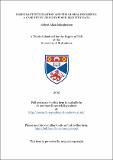Files in this item
Immigrant integration and the global recession : a case study using Swedish register data
Item metadata
| dc.contributor.advisor | Findlay, Allan M. | |
| dc.contributor.advisor | Geddes, A. (Alistair) | |
| dc.contributor.author | Macpherson, Robert Allan | |
| dc.coverage.spatial | xx, 305 p. | en_US |
| dc.date.accessioned | 2015-10-05T13:09:27Z | |
| dc.date.available | 2015-10-05T13:09:27Z | |
| dc.date.issued | 2015-11-30 | |
| dc.identifier.uri | https://hdl.handle.net/10023/7598 | |
| dc.description.abstract | In many immigrant-receiving countries, the increased rate and diversification of immigration has placed immigrant integration high on academic and political agendas. Immigrant integration must also be understood within increasingly complex contexts due to the global recession and new geographies of immigrant settlement. The aim of this thesis is to deepen understanding of immigrant integration processes during the recession by using Sweden as an empirical lens. Using Swedish register data, this thesis examines the registered population during the recent economic boom and bust to explore how the recession may have resulted in differential labour market and migration outcomes between immigrants and natives. The first empirical chapter highlights how long-term processes have produced a spatial, immigrant division of labour that results in differential risks of unemployment during the recession. The second empirical chapter examines internal migration to show that although cyclical patterns of the economy offer some explanation of the differences in experiences between immigrant and natives, long-term, deeper processes are more important in understanding geographies of immigrant integration. The final empirical chapter examines a recent immigrant cohort to show that labour market entry is by no means uniform across time, space and immigrant origin. Conceptually, the thesis shows that existing theories of immigrant integration processes during recessions are underdeveloped and that processes taking place across other temporal and spatial scales offer deeper explanation for the differential outcomes between immigrants and natives. The thesis also reveals what is knowable from register data and how such data allows future research to present a more holistic picture of how various forms of immigrant integration play out across time (economic cycles, lifecourse, generations) and across space (urban, rural areas, old and new immigrant destinations). This methodological contribution is significant given that social scientists are currently evaluating the relative merits of population censuses versus administrative register data. | en_US |
| dc.language.iso | en | en_US |
| dc.publisher | University of St Andrews | |
| dc.subject | Immigration | en_US |
| dc.subject | Integration | en_US |
| dc.subject | Recession | en_US |
| dc.subject | Labour markets | en_US |
| dc.subject | Internal migration | en_US |
| dc.subject | Sweden | en_US |
| dc.subject | Register data | en_US |
| dc.subject.lcc | HV6342.M7 | |
| dc.subject.lcsh | Immigrants--Cultural assimilation | en_US |
| dc.subject.lcsh | Immigrants--Sweden--Case studies | en_US |
| dc.subject.lcsh | Labor market | en_US |
| dc.title | Immigrant integration and the global recession : a case study using Swedish register data | en_US |
| dc.type | Thesis | en_US |
| dc.contributor.sponsor | Economic and Social Research Council (ESRC) | en_US |
| dc.type.qualificationlevel | Doctoral | en_US |
| dc.type.qualificationname | PhD Doctor of Philosophy | en_US |
| dc.publisher.institution | The University of St Andrews | en_US |
This item appears in the following Collection(s)
Items in the St Andrews Research Repository are protected by copyright, with all rights reserved, unless otherwise indicated.

